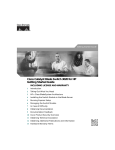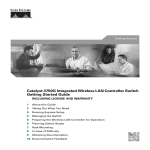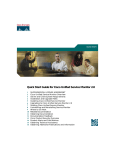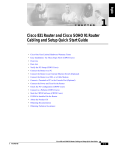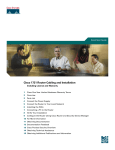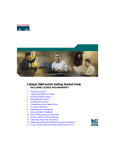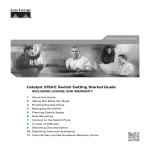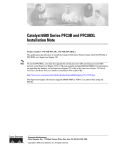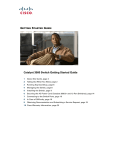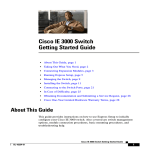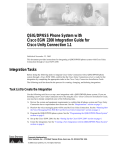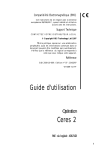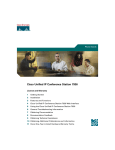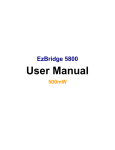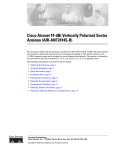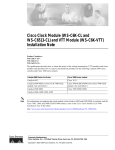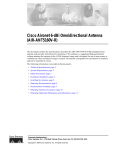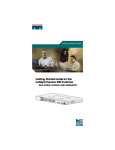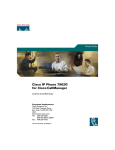Download Cisco Systems CATALYST 2940 User's Manual
Transcript
Getting Started Guide Catalyst 2940 Switch Getting Started Guide INCLUDING LICENSE AND WARRANTY 1 About this Guide 2 Taking Out What You Need 3 Running Express Setup 4 Managing the Switch 5 Installing the Switch 6 In Case of Difficulty 7 Obtaining Documentation 8 Obtaining Technical Assistance 9 Cisco Limited Lifetime Hardware Warranty Terms 1 About this Guide This guide provides instructions on how to use Express Setup to initially configure your Catalyst switch. Also covered are switch management options, basic installation procedures, port and module connections, and troubleshooting help. For additional installation and configuration information, and technical specifications, refer to the Catalyst 2940 documentation on Cisco.com. For system requirements, important notes, limitations, open and resolved bugs, and last-minute documentation updates, see the release notes, also on Cisco.com. When using the online publications, refer to the documents that match the Cisco IOS software version running on the switch. The software version is on the Cisco IOS label on the switch rear panel. You can order printed copies of the manuals from the Cisco.com sites and from the telephone numbers listed in the “Obtaining Documentation” section on page 18. For translations of the warnings that appear in this publication, refer to the Regulatory Compliance and Safety Information for the Catalyst 2940 Switch that accompanies this guide. 2 Taking Out What You Need Follow these steps: 1. Unpack and remove the switch and the accessory kit from the shipping box. 2. Return the packing material to the shipping container, and save it for future use. 3. Verify that you have received the items shown on page 3. If any item is missing or damaged, contact your Cisco representative or reseller for instructions. Some switch models might include additional items that are not shown on page 3. Equipment That You Supply to Run Express Setup You need to supply this equipment to run Express Setup: • PC • Ethernet (Category 5) straight-through cable (as shown) 2 Shipping Box Contents SYST 1x STAT DPLX 2x 3x SPD 4x 5x MODE 6x 7x 8x 1 Catalyst 29 40 SERIES Catalyst 2940 switch Mounting magnet Console cable Screw template AC power cord (AC-powered switches only) Three number-8 Phillips pan-head screws e nc ia on pl ti a om rm h C o itc y Inf w or y e S at et th 0 ul af for 94 eg S t2 R nd ys a al at C h itc w de S ui 0 G 94 ed t 2 art ys t al S at ng C tti e G Ci sc d ro P gis o ct u Re ard p hi rs nc ne tio w O tra Documentation Four rubber mounting feet 3 3 Running Express Setup When you first set up the switch, you should use Express Setup to enter the initial IP information. This enables the switch to connect to local routers and the Internet. You can then access the switch through the IP address for further configuration. To run Express Setup: Step 1 Verify that no devices are connected to the switch, because during Express Setup, the switch acts as a DHCP server. If your PC has a static IP address, before you begin you should change your PC settings to temporarily use DHCP. Step 2 Connect the AC power cord to the switch and to a grounded AC outlet. The power-on self-test (POST) begins. During POST, the LEDs blink while a series of tests verify that the switch functions properly. Step 3 Wait for the switch to complete POST. It might take several minutes for the switch to complete POST. Step 4 Verify that POST has completed by confirming that the SYST and STAT LEDs are green. Step 5 Press and hold the Mode button for 3 seconds. When all of the LEDs above the Mode button turn green, release the Mode button. SYST If the LEDs above the Mode button begin to blink after you press the button, release it. Blinking LEDs mean that the switch has already been configured and cannot go into Express Setup mode. For more information, see the “Resetting the Switch” section on page 16. Step 6 4 1x STAT DPLX SPD 2x 3x 4x 5x MODE Mode button Verify that the switch is in Express Setup mode by confirming that all LEDs above the Mode button are green. Step 7 Connect a straight-through Category 5 Ethernet cable (not provided) to any 10/100 or 10/100/1000 Ethernet port on the switch front panel and to the Ethernet port on the PC. SYST 1x STAT DPLX SPD 2x 3x 4x 5x 6x MODE 7x 8x 1 Catalyst 294 0 SERIES DHCP-enabled PC Step 8 Verify that the LEDs on both Ethernet ports are green. Step 9 Wait 30 seconds. Step 10 Launch a web browser on your PC. Enter the IP address 10.0.0.1 in the web browser, and press Enter. Step 11 The Express Setup page appears. If it does not appear, see the “In Case of Difficulty” section on page 15 for help. 5 Step 12 Enter this information in the Network Settings fields: • In the Management Interface (VLAN ID) field, the default is 1. Enter a new VLAN ID only if you want to change the management interface through which you manage the switch and to which you assign IP information. The VLAN ID range is 1 to 1001. • In the IP Address field, enter the IP address of the switch. In the IP Subnet Mask field, click the drop-down arrow, and select an IP Subnet Mask. • In the Default Gateway field, enter the IP address for the default gateway (router). • Enter your password in the Switch Password field. The password can be from 1 to 25 alphanumeric characters, can start with a number, is case sensitive, allows embedded spaces, but does not allow spaces at the beginning or end. In the Confirm Switch Password field, enter your password again. Step 13 (Optional) You can enter the Optional Settings information now or enter it later by using the device manager interface: • In the Host Name field, enter a name for the switch. The host name is limited to 31 characters; embedded spaces are not allowed. • In the System Contact field, enter the name of the person responsible for the switch. In the System Location field, enter the wiring closet, floor, or building where the switch is located. • In the Telnet Access field, click Enable if you are going to use Telnet to manage the switch by using the command-line interface (CLI). If you enable Telnet access, you must enter a Telnet password. • In the Telnet Password field, enter a password. The Telnet password can be from 1 to 25 alphanumeric characters, is case sensitive, allows embedded spaces, but does not allow spaces at the beginning or end. In the Confirm Telnet Password field, enter the Telnet password again. • In the SNMP field, click Enable to enable Simple Network Management Protocol (SNMP). Enable SNMP only if you plan to manage switches by using CiscoWorks2000 or another SNMP-based network-management system. If you enable SNMP, you must enter a community string in the SNMP Read Community field, the SNMP Write Community field, or both. SNMP community strings authenticate access to MIB objects. Embedded spaces are not allowed in SNMP community strings. When you set the SNMP read community, you can access SNMP information, but cannot modify it. When set the SNMP write community, you can access and modify SNMP information. 6 Step 14 Click Submit to save your settings, or click Cancel to clear your settings. When you click Submit, the switch is configured and exits Express Setup mode. The PC displays a warning message and then attempts to connect with the new switch IP address. If you configured the switch with an IP address that is in a different subnet from the PC, connectivity between the PC and the switch is lost. Step 15 Disconnect the switch from the PC, and install the switch in your production network. See the “Managing the Switch” section on page 7 for information about configuring and managing the switch. If you need to rerun Express Setup, see the “Resetting the Switch” section on page 16. Refreshing the PC IP Address After you complete Express Setup, you should refresh the PC IP address. For a dynamically assigned IP address, disconnect the PC from the switch, and reconnect it to the network. The network DHCP server will assign a new IP address to the PC. For a statically assigned IP address, change it to the previously configured IP address. 4 Managing the Switch After completing Express Setup and installing the switch in your network, use the device manager or other management options described in this section for further configuration. Using the Device Manager The simplest way to manage the switch is by using the device manager that is in the switch memory. This is an easy-to-use web interface that offers quick configuration and monitoring. You can access the device manager from anywhere in your network through a web browser. Follow these steps: 1. Launch a web browser on your PC or workstation. 2. Enter the switch IP address in the web browser, and press Enter. The device manager page appears. 3. Use the device manager to perform basic switch configuration and monitoring. Refer to the device manager online help for more information. 4. For more advanced configuration, download and run the Cisco Network Assistant described in the next section. 7 Downloading Cisco Network Assistant Cisco Network Assistant is a free software program that you download from Cisco.com and run on your PC. Network Assistant offers advanced options for configuring and monitoring multiple devices, including switches, switch clusters, switch stacks, routers, and access points. Follow these steps: 1. From the device manager page, select Network Assistant. 2. Follow the instructions to download the program to your PC. 3. Use the Network Assistant to configure and monitor multiple switches and devices. Refer to the Network Assistant online help and the getting started guide for more information. Command-Line Interface You can enter Cisco IOS commands and parameters through the CLI. Access the CLI either by connecting your PC directly to the switch console port or through a Telnet session from a remote PC or workstation. Follow these steps: 1. Connect the supplied RJ-45-to DB-9 adapter cable to the standard 9-pin serial port on the PC. Connect the other end of the cable to the console port on the switch. 2. Start a terminal-emulation program on the PC. 3. Configure the PC terminal emulation software for 9600 baud, 8 data bits, no parity, 1 stop bit, and no flow control. 4. Use the CLI to enter commands to configure the switch. Refer to the software configuration guide and the command reference for more information. Other Management Options You can use SNMP management applications such as CiscoWorks Small Network Management Solution (SNMS) and HP OpenView to configure and manage the switch. You also can manage it from an SNMP-compatible workstation that is running platforms such as HP OpenView or SunNet Manager. The Cisco IE2100 Series Configuration Registrar is a network management device that works with embedded CNS agents in the switch software. You can use IE2100 to automate initial configurations and configuration updates on the switch. See the “Accessing Help Online” section on page 16 for a list of supporting documentation. 8 5 Installing the Switch This section covers switch installation and port connections. For additional installation and cabling information, refer to the Catalyst 2940 Switch Hardware Installation Guide on Cisco.com. You can order an optional cable guard to secure cables to the front of the switch and prevent them from being accidentally removed. To order a cable guard, contact your Cisco representative. The switch has security slots in the left and right side panels. You can install an optional cable lock, such as the type that is used to secure a laptop computer, to secure either or both sides of the switch. Cable locks are available from most computer accessory suppliers. Equipment That You Supply You need this equipment to install the switch: • Number-2 Phillips screwdriver • Drill with a #27 drill bit (0.144-inch [3.7 mm]) Before you Begin When determining where to install the switch, verify that these guidelines are met: • Airflow around the switch and through the vents is unrestricted. • Temperature around the switch does not exceed 113°F (45°C). • Humidity around the switch does not exceed 85 percent. • Altitude at the installation site is not greater than 10,000 feet (3049 m). • Clearance to the switch front and rear panels meets these conditions: – Front-panel LEDs can be easily read. • Cabling is away from sources of electrical noise, such as radios, power lines, and fluorescent lighting fixtures. • For 10/100 ports and the 10/100/1000 port, the cable length from a switch to an attached device cannot exceed 328 feet (100 meters). • For the 100BASE-FX port, the cable length from a switch to an attached device cannot exceed 6562 feet (2 kilometers). • For cable lengths for small form-factor pluggable (SFP) modules, refer to the documentation that shipped with the module. – Access to ports is sufficient for unrestricted cabling. – AC power cord can reach from the AC power outlet to the connector on the switch front or rear panel. 9 Installation Warning Statements This section includes the basic installation warning statements. Warning To prevent the switch from overheating, do not operate it in an area that exceeds the maximum recommended ambient temperature of 113°F (45°C). To prevent airflow restriction, allow at least 3 inches (7.6 cm) of clearance around the ventilation openings. Statement 17B Warning This equipment is intended to be grounded. Ensure that the host is connected to earth ground during normal use. Statement 39 Warning Only trained and qualified personnel should be allowed to install, replace, or service this equipment. Statement 148 Warning Do not work on the system or connect or disconnect cables during periods of lightning activity. Statement 1001 Warning Class 1 laser product. Statement 1008 Warning The plug-socket combination must be accessible at all times, because it serves as the main disconnecting device. Statement 1019 Warning Installation of the equipment must comply with local and national electrical codes. Statement 1074 10 Installing the Switch on a Desk or Wall To place the switch on a desk without using the mounting screws, simply attach the four rubber feet on the bottom panel of the switch. To install the switch on top of a desk, under a desk, or on a wall, use the mounting template and three mounting screws. Follow these steps: 1. Position the screw template on the mounting surface with the two side-by-side slots forward. Peel the adhesive strip off the bottom and attach the template. 2. Use a 0.144-inch (3.7 mm) or a #27 drill bit to drill a 1/2-inch (12.7 mm) hole in the three template screw slot positions. 3. Insert the screws in the slots on the template and tighten until they touch the template. Remove the template from the mounting surface. 4. Place the switch onto the mounting screws, and slide it forward until it locks in place. Number-8 Phillips pan-head screws Mounting template SYST 1x STAT DPLX SPD MODE 2x 3x 4x 5x 6x 7x 8x 1 Catalyst 29 40 SERIES 11 Installing the Switch Using the Magnet Mount Follow these steps: 1. Position the magnetic panel on the mounting surface. 2. Place the bottom of the switch on the magnetic panel. Metal mounting surface Mounting magnet Switch bottom panel 40 SERIES Catalyst 29 SPD DPLX STAT SYST 12 Connecting to the Switch Ports This section describes how to connect to the fixed switch ports and to the SFP module port. For additional cabling information and a list of supported SFP modules, refer to the hardware installation guide on Cisco.com. Connect to 10/100 Ports and the 10/100/1000 Port Follow these steps: Step 1 Step 2 When you connect to servers, workstations, IP phones, wireless access points, and routers, insert a straight-through, twisted four-pair, Category 5 cable in a switch 10/100 or 10/100/1000 port. Use a crossover, twisted four-pair, Category 5 cable when you connect to other switches, hubs, or repeaters. SYST 1x STAT DPLX SPD 2x 3x 4x 5x 6x MODE 7x 8x Catalyst 294 0 SERIES 1 10/100 port 10/100/ 1000 port Insert the other cable end into an RJ-45 connector on the other device. Connect to the 100BASE-FX Port You can use either the 100BASE-FX port or the SFP module slot, but not both at the same time. By default, the 100BASE-FX port is active if an SFP module is not installed in the switch at startup. Follow these steps: Step 1 Remove the dust plugs from the 100BASE-FX port and the rubber caps from the MT-RJ patch cable. Store them for future use. Step 2 Insert an appropriate cable into the 100BASE-FX port. Insert the other cable end into an SC port on the other device. 7x 8x 9 100Base-F X 1 SFP Catalyst 29 40 SERIES 100BASE-FX port 13 Install and Connect to SFP Module Port You can use either the 100BASE-FX port or the SFP module slot, but not both at the same time. By default, the 100BASE-FX port is active if an SFP module is not installed in the switch at startup. If you install an SFP module after the switch has powered on, you must reload the switch to enable the SFP module. Follow these steps: Step 1 Grasp the module on the sides, and insert it into the switch slot until you feel the connector snap into place. 9 100Base-F Catalyst 29 40 SERIES 1 SFP X SFP module Step 2 Insert an appropriate cable into the module port. Insert the other cable end into the other device. 9 100Base-F X 1 SFP Catalyst 29 40 SERIES SFP module port Caution Removing and installing an SFP module can shorten its useful life. Do not remove and insert SFP modules more often than is absolutely necessary. After you connect to the switch port, the port LED turns amber while the switch establishes a link. This process takes about 30 seconds, and then the LED turns green when the switch and the target device have an established link. If the LED is off, the target device might not be turned on, there might be a cable problem, or there might be a problem with the adapter installed in the target device. See the “In Case of Difficulty” section on page 15 for information about online assistance. 14 6 In Case of Difficulty If you experience difficulty, help is available here and on Cisco.com. This section includes Express Setup troubleshooting, how to reset the switch, how to access help online, and where to find more information. Troubleshooting Express Setup If Express Setup does not run, or if the Express Setup page does not appear in your browser: • Did you verify that POST successfully ran before starting Express Setup? If not, make sure that only the SYST and STAT LEDs are green before pressing the Mode button to enter the Express Setup mode. • Did you press the Mode button while the switch was still running POST? If yes, wait until POST completes. Power cycle the switch. Wait until POST completes. Confirm that the SYST and STAT LEDs are green. Press the Mode button to enter Express Setup mode. • Did you try to continue without confirming that the switch was in Express Setup mode? Verify that all LEDs above the Mode button are green. If necessary, press the Mode button to enter Express Setup mode. • Does your PC have a static IP address? If yes, before connecting to the switch change your PC settings to temporarily use DHCP. • Did you connect a crossover cable instead of If yes, connect a straight-through cable to an a straight-through Ethernet cable between a Ethernet port on the switch and PC. Wait 30 switch port and the Ethernet port of the PC? seconds before entering 10.0.0.1 in the browser. • Did you connect the Ethernet cable to the console port instead of to a 10/100 or 10/100/1000 Ethernet port on the switch? If yes, disconnect from the console port. Connect to an Ethernet port on the switch and PC. Wait 30 seconds before entering 10.0.0.1 in the browser. • Did you wait 30 seconds after connecting the If not, wait 30 seconds, re-enter 10.0.0.1 in the switch and PC before entering the IP address browser, and press Enter. in your browser? • Did you enter the wrong address in the browser, or is there an error message? If yes, re-enter 10.0.0.1 in the browser, and press Enter. 15 Resetting the Switch This section describes how to reset the switch by rerunning Express Setup. These are reasons why you might want to reset the switch: • You installed the switch in your network and cannot connect to it because you assigned the wrong IP address. • You want to clear all configuration from the switch and assign a new IP address. • You are trying to enter Express Setup mode and the switch LEDs start blinking when you press the Mode button (which means that the switch is already configured with IP information). Caution Resetting the switch deletes the configuration and reboots the switch. To reset the switch: • Press and hold the Mode button. The switch LEDs begin blinking after about 2 seconds. Continue holding down the Mode button. The LEDs stop blinking after 8 more seconds, and then the switch reboots. The switch now behaves like an unconfigured switch. You can enter the switch IP information by using Express Setup as described in the “Running Express Setup” section on page 4. Accessing Help Online First look for a solution to your problem in the troubleshooting section of the Catalyst 2940 Hardware Installation Guide or the Catalyst 2940 Software Configuration Guide on Cisco.com. You can also access the Cisco Technical Support and Documentation website for a list of known hardware problems and extensive troubleshooting documentation, including: • Factory defaults and password recovery • Recovery from corrupted or missing software • Switch port problems • Network interface cards • Troubleshooting tools • Field notices and security advisories 16 Follow these steps: 1. Open your browser, and go to http://www.cisco.com/. 2. Click Technical Support. 3. Click Product Support > Switches > Catalyst LAN and ATM Switches > 2940 Series Switches > Troubleshooting. 4. Click the subject that addresses the problem that you are experiencing. For More Information For more information about the switch, refer to these documents on Cisco.com: • Catalyst 2940 Switch Hardware Installation Guide (not orderable but available on Cisco.com). This guide provides complete hardware descriptions and detailed installation procedures. • Regulatory Compliance and Safety Information for the Catalyst 2940 Switch (order number DOC-7816656). This guide contains agency approvals, compliance information, and translated warning statements. • Catalyst 2940 Switch Software Configuration Guide (order number DOC-7815507=). This guide provides a product overview and detailed descriptions and procedures of the switch software features. • Catalyst 2940 Switch Command Reference (order number DOC-7815505=). This reference provides detailed descriptions of the Cisco IOS commands specifically created or modified for the switch. • Catalyst 2940 Switch System Message Guide (order number DOC-7815524=). This guide provides descriptions of the system messages specifically created or modified for the switch. 17 7 Obtaining Documentation Cisco documentation and additional literature are available on Cisco.com. Cisco also provides several ways to obtain technical assistance and other technical resources. These sections explain how to obtain technical information from Cisco Systems. Cisco.com You can access the most current Cisco documentation at this URL: http://www.cisco.com/univercd/home/home.htm You can access the Cisco website at this URL: http://www.cisco.com You can access international Cisco websites at this URL: http://www.cisco.com/public/countries_languages.shtml Ordering Documentation You can find instructions for ordering documentation at this URL: http://www.cisco.com/univercd/cc/td/doc/es_inpck/pdi.htm You can order Cisco documentation in these ways: • Registered Cisco.com users (Cisco direct customers) can order Cisco product documentation from the Ordering tool: http://www.cisco.com/en/US/partner/ordering/index.shtml • Nonregistered Cisco.com users can order documentation through a local account representative by calling Cisco Systems Corporate Headquarters (California, USA) at 408 526-7208 or, elsewhere in North America, by calling 1 800 553-NETS (6387). Documentation Feedback You can send comments about technical documentation to [email protected]. 18 You can submit comments by using the response card (if present) behind the front cover of your document or by writing to the following address: Cisco Systems Attn: Customer Document Ordering 170 West Tasman Drive San Jose, CA 95134-9883 We appreciate your comments. 8 Obtaining Technical Assistance For all customers, partners, resellers, and distributors who hold valid Cisco service contracts, Cisco Technical Support provides 24-hour-a-day, award-winning technical assistance. The Cisco Technical Support Website on Cisco.com features extensive online support resources. In addition, Cisco Technical Assistance Center (TAC) engineers provide telephone support. If you do not hold a valid Cisco service contract, contact your reseller. Cisco Technical Support Website The Cisco Technical Support Website provides online documents and tools for troubleshooting and resolving technical issues with Cisco products and technologies. The website is available 24 hours a day, 365 days a year, at this URL: http://www.cisco.com/techsupport Access to all tools on the Cisco Technical Support Website requires a Cisco.com user ID and password. If you have a valid service contract but do not have a user ID or password, you can register at this URL: http://tools.cisco.com/RPF/register/register.do Note Use the Cisco Product Identification (CPI) tool to locate your product serial number before submitting a web or phone request for service. You can access the CPI tool from the Cisco Technical Support Website by clicking the Tools & Resources link under Documentation & Tools. Choose Cisco Product Identification Tool from the Alphabetical Index drop-down list, or click the Cisco Product Identification Tool link under Alerts & RMAs. The CPI tool offers three search options: by product ID or model name; by tree view; or for certain products, by copying and pasting show command output. Search results show an illustration of your product with the serial number label location highlighted. Locate the serial number label on your product and record the information before placing a service call. 19 Submitting a Service Request Using the online TAC Service Request Tool is the fastest way to open S3 and S4 service requests. (S3 and S4 service requests are those in which your network is minimally impaired or for which you require product information.) After you describe your situation, the TAC Service Request Tool provides recommended solutions. If your issue is not resolved using the recommended resources, your service request is assigned to a Cisco TAC engineer. The TAC Service Request Tool is located at this URL: http://www.cisco.com/techsupport/servicerequest For S1 or S2 service requests or if you do not have Internet access, contact the Cisco TAC by telephone. (S1 or S2 service requests are those in which your production network is down or severely degraded.) Cisco TAC engineers are assigned immediately to S1 and S2 service requests to help keep your business operations running smoothly. To open a service request by telephone, use one of the following numbers: Asia-Pacific: +61 2 8446 7411 (Australia: 1 800 805 227) EMEA: +32 2 704 55 55 USA: 1 800 553-2447 For a complete list of Cisco TAC contacts, go to this URL: http://www.cisco.com/techsupport/contacts Definitions of Service Request Severity To ensure that all service requests are reported in a standard format, Cisco has established severity definitions. Severity 1 (S1)—Your network is “down,” or there is a critical impact to your business operations. You and Cisco will commit all necessary resources around the clock to resolve the situation. Severity 2 (S2)—Operation of an existing network is severely degraded, or significant aspects of your business operation are negatively affected by inadequate performance of Cisco products. You and Cisco will commit full-time resources during normal business hours to resolve the situation. Severity 3 (S3)—Operational performance of your network is impaired, but most business operations remain functional. You and Cisco will commit resources during normal business hours to restore service to satisfactory levels. Severity 4 (S4)—You require information or assistance with Cisco product capabilities, installation, or configuration. There is little or no effect on your business operations. 20 Obtaining Additional Publications and Information Information about Cisco products, technologies, and network solutions is available from various online and printed sources. • Cisco Marketplace provides a variety of Cisco books, reference guides, and logo merchandise. Visit Cisco Marketplace, the company store, at this URL: http://www.cisco.com/go/marketplace/ • The Cisco Product Catalog describes the networking products offered by Cisco Systems, as well as ordering and customer support services. Access the Cisco Product Catalog at this URL: http://cisco.com/univercd/cc/td/doc/pcat/ • Cisco Press publishes a wide range of general networking, training and certification titles. Both new and experienced users will benefit from these publications. For current Cisco Press titles and other information, go to Cisco Press at this URL: http://www.ciscopress.com • Packet magazine is the Cisco Systems technical user magazine for maximizing Internet and networking investments. Each quarter, Packet delivers coverage of the latest industry trends, technology breakthroughs, and Cisco products and solutions, as well as network deployment and troubleshooting tips, configuration examples, customer case studies, certification and training information, and links to scores of in-depth online resources. You can access Packet magazine at this URL: http://www.cisco.com/packet • iQ Magazine is the quarterly publication from Cisco Systems designed to help growing companies learn how they can use technology to increase revenue, streamline their business, and expand services. The publication identifies the challenges facing these companies and the technologies to help solve them, using real-world case studies and business strategies to help readers make sound technology investment decisions. You can access iQ Magazine at this URL: http://www.cisco.com/go/iqmagazine • Internet Protocol Journal is a quarterly journal published by Cisco Systems for engineering professionals involved in designing, developing, and operating public and private internets and intranets. You can access the Internet Protocol Journal at this URL: http://www.cisco.com/ipj • World-class networking training is available from Cisco. You can view current offerings at this URL: http://www.cisco.com/en/US/learning/index.html 21 9 Cisco Limited Lifetime Hardware Warranty Terms There are special terms applicable to your hardware warranty and various services that you can use during the warranty period. Your formal Warranty Statement, including the warranties and license agreements applicable to Cisco software, is available on Cisco.com. Follow these steps to access and download the Cisco Information Packet and your warranty and license agreements from Cisco.com. 1. Launch your browser, and go to this URL: http://www.cisco.com/univercd/cc/td/doc/es_inpck/cetrans.htm The Warranties and License Agreements page appears. 2. To read the Cisco Information Packet, follow these steps: a. Click the Information Packet Number field, and make sure that the part number 78-5235-03A0 is highlighted. b. Select the language in which you would like to read the document. c. Click Go. The Cisco Limited Warranty and Software License page from the Information Packet appears. d. Read the document online, or click the PDF icon to download and print the document in Adobe Portable Document Format (PDF). Note You must have Adobe Acrobat Reader to view and print PDF files. You can download the reader from Adobe’s website: http://www.adobe.com 3. To read translated and localized warranty information about your product, follow these steps: a. Enter this part number in the Warranty Document Number field: 78-6310-02C0 b. Select the language in which you would like to view the document. c. Click Go. The Cisco warranty page appears. d. Read the document online, or click the PDF icon to download and print the document in Adobe Portable Document Format (PDF). You can also contact the Cisco service and support website for assistance: http://www.cisco.com/public/Support_root.shtml. 22 Duration of Hardware Warranty A Cisco product hardware warranty is supported for as long as the original end user continues to own or use the product, provided that the fan and power supply warranty is limited to five (5) years. In the event of a discontinuance of product manufacture, the Cisco warranty support is limited to five (5) years from the announcement of the discontinuance. Replacement, Repair, or Refund Policy for Hardware Cisco or its service center will use commercially reasonable efforts to ship a replacement part within ten (10) working days after receipt of the Return Materials Authorization (RMA) request. Actual delivery times can vary, depending on the customer location. Cisco reserves the right to refund the purchase price as its exclusive warranty remedy. To Receive a Return Materials Authorization (RMA) Number Contact the company from whom you purchased the product. If you purchased the product directly from Cisco, contact your Cisco Sales and Service Representative. Complete the information below, and keep it for reference. Company product purchased from Company telephone number Product model number Product serial number Maintenance contract number 23 Corporate Headquarters Cisco Systems, Inc. 170 West Tasman Drive San Jose, CA 95134-1706 USA www.cisco.com Tel: 408 526-4000 800 553-NETS (6387) Fax: 408 526-4100 European Headquarters Cisco Systems International BV Haarlerbergpark Haarlerbergweg 13-19 1101 CH Amsterdam The Netherlands www-europe.cisco.com Tel: 31 0 20 357 1000 Fax: 31 0 20 357 1100 Americas Headquarters Cisco Systems, Inc. 170 West Tasman Drive San Jose, CA 95134-1706 USA www.cisco.com Tel: 408 526-7660 Fax: 408 527-0883 Asia Pacific Headquarters Cisco Systems, Inc. 168 Robinson Road #28-01 Capital Tower Singapore 068912 www.cisco.com Tel: +65 6317 7777 Fax: +65 6317 7799 Cisco Systems has more than 200 offices in the following countries. Addresses, phone numbers, and fax numbers are listed on the Cisco Website at www.cisco.com/go/offices Argentina • Australia • Austria • Belgium • Brazil • Bulgaria • Canada • Chile • China PRC • Colombia • Costa Rica • Croatia • Cyprus • Czech Republic • Denmark • Dubai, UAE Finland • France • Germany • Greece • Hong Kong SAR • Hungary • India • Indonesia • Ireland • Israel • Italy • Japan • Korea • Luxembourg • Malaysia • Mexico The Netherlands • New Zealand • Norway • Peru • Philippines • Poland • Portugal • Puerto Rico • Romania • Russia • Saudi Arabia • Scotland • Singapore Slovakia • Slovenia • South Africa • Spain • Sweden • Switzerland • Taiwan • Thailand • Turkey • Ukraine • United Kingdom • United States • Venezuela • Vietnam • Zimbabwe CCVP, the Cisco logo, and the Cisco Square Bridge logo are trademarks of Cisco Systems, Inc.; Changing the Way We Work, Live, Play, and Learn is a service mark of Cisco Systems, Inc.; and Access Registrar, Aironet, BPX, Catalyst, CCDA, CCDP, CCIE, CCIP, CCNA, CCNP, CCSP, Cisco, the Cisco Certified Internetwork Expet logo, Cisco IOS, Cisco Press, Cisco Systems, Cisco Systems Capital, the Cisco Systems logo, Cisco Unity, Enterprise/Solver, EtherChannel, EtherFast, EtherSwitch, Fast Step, Follow Me Browsing, FormShare, GigaDrive, HomeLink, Internet Quotient, IOS, iPhone, IP/TV, iQ Expertise, the iQ logo, iQ Net Readiness Scorecard, iQuick Study, LightStream, Linksys, MeetingPlace, MGX, Networking Academy, Network Registrar, Packet, PIX, ProConnect, ScriptShare, SMARTnet, StackWise, The Fastest Way to Increase Your Internet Quotient, and TransPath are registered trademarks of Cisco Systems, Inc. and/or its affiliates in the United States and certain other countries. All other trademarks mentioned in this document or Website are the property of their respective owners. The use of the word partner does not imply a partnership relationship between Cisco and any other company. (0705R) Printed in the USA on recycled paper containing 10% postconsumer waste. 78-16576-01 DOC-7816576=

























